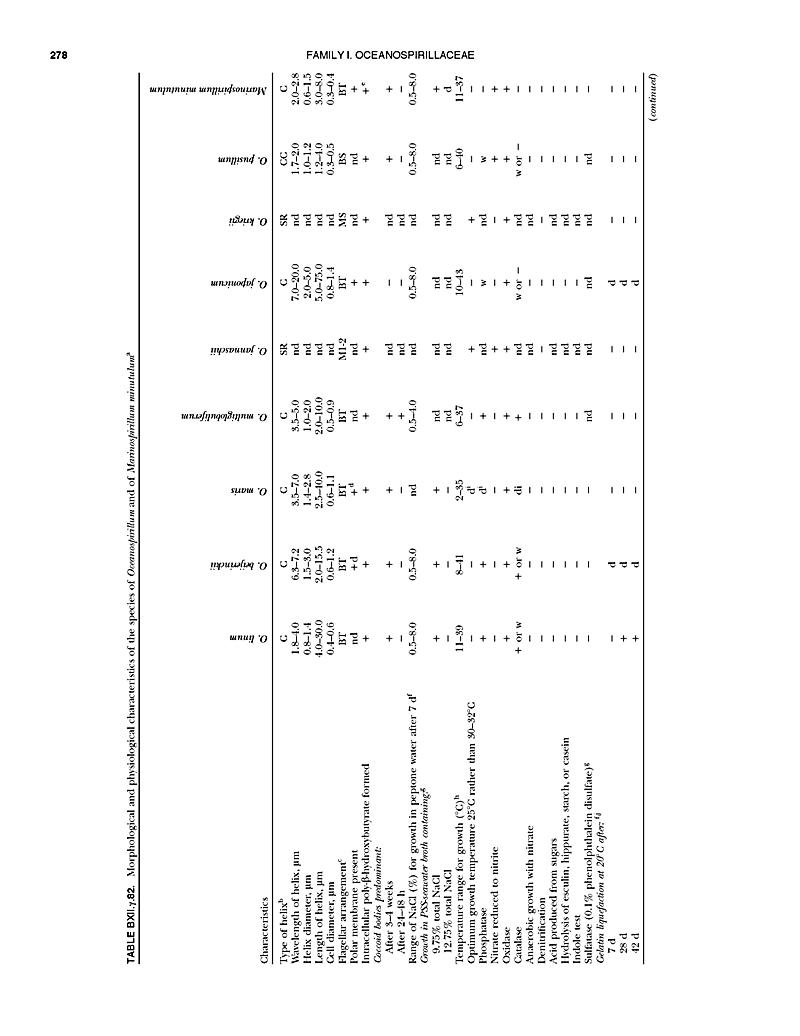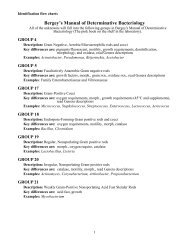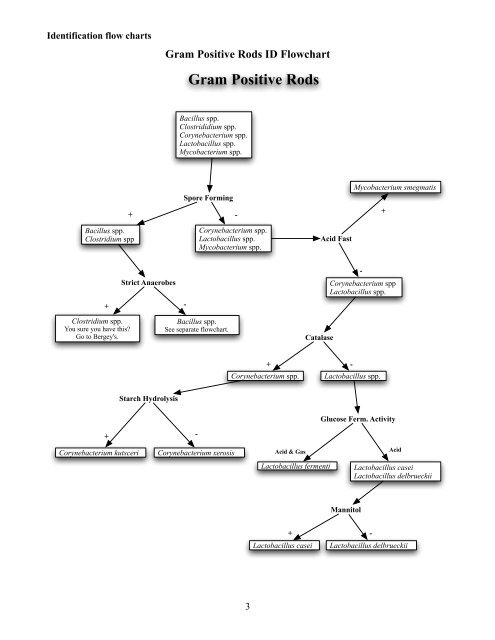The following points highlight the top four Volumes of Bergey’s Manual of Systematic Bacteriology.
- Bergey's Manual Chart
- Bergey's Manual Chart Gram Positive Rod
- Bergey's Manual Identification Chart
- Bergey's Manual Flow Chart
Manuals Lab Paper Preview text Identification flow charts Manual of Determinative Bacteriology All of the unknowns will fall into the following groups in Manual of Determinative Bacteriology (The pink book on the shelf in the laboratory). The complexity of scientific problems is exemplified in this elaborate system of classification of bacteria. Not long ago bacteria were classified by their morphology into a few simple classes, such as bacilli, cocci and spirilla. Today even this manual of nearly 600 pages is in no sense final but. Bergey’s manual of bacterial classification 1. Bergey’s manual of bacterial classification Presented by: Kanta Yadav Noopur Joshi Department of: Biotechnology 2. INTRODUCTION TO MICROBIAL TAXONOMY AND CLASSIFICATION 3. TAXONOMY. Is defined as the science of biological classification.
Bergey’s Manual of Systematic Bacteriology # Volume I:
The organization of Bergey's Manual of Systematic Bacteriology makes it impractical for helping place unknown bacteria into major taxa, but it contains far more detail on the families, genera, and species and is far more up to date than the Determinative manual. You will need to consult this information in order to double check and finalize. Bergeys manual automatic flow chart #28 – Automatic Flow Chart, with 37 Similar files. Resume Templates & Printable Documents IthacaHighAlumni.com. Bergey’s manual of bacterial classification 1. Bergey’s manual of bacterial classification Presented by: Kanta Yadav Noopur Joshi Department of: Biotechnology 2.
Section 1: The spirochetes
Order I. Spirochaetals.
ADVERTISEMENTS:
Family I. Spirochaetaceae e.g., Spirochaeta.
Family II. Leptospiraceae e.g., Leptospira.
Section 2: Aerobic, microaerophilic, motile, helical, vibroid, Gram negative curved bacteria, e.g., Aquaspirlllum, Azospirillum, spirillum .
Section 3: Normotile (or rarely motile), Gram negative curved bacteria.
Family I: Spirosomaceae, e.g., spirosoma.
Section 4: Gram negative aerobic rods and cocci.
Family I: Pseudomonadaceae e.g., Pseudomonas.
Family II: Azotobacteraceae e.g., Azotobacter.
Family III: Rhizobiaceae e.g., Rhizobium.
Family IV : Methylococcaceae e.g., Methylococcus.
Family V : Halobacteriaceae e.g., Halobacterium.

Family VI: Acetobacteriaceae e.g., Acetobacter.
Family VII: Legionellaceae e.g., Legionella.
ADVERTISEMENTS:
Family VIII: Neisseriaceae e.g., Neisseria, Beizeriuckia.
Section 5: Facultatively anaerobic Gram-negative rods e.g.,
Family I: Enterobacteriaceae e.g., Escherichia, shigella, salmonella, klbsiella, Yersia.
Family II: Vibrionaceae, e.g., Vibrio.
Family III: Pasteuellaceae e.g., Actinobacillus Haemophilus.
Section 6: Anaerobic Gram negative straight, curved and helical rods.
Family I: Bacteroidaceae e.g., Bacteroides.
Section 7: dissimilatory sulphate or sulphur reducing bacteria e.g., Desulfuromonas, Desulfobacter.
ADVERTISEMENTS:
Section 8 : Anaerobic Gram-negative cocci.
Family I: Veillonellacae e.g.,veillonella.
Section 9: Rickettsias and chlamydia orders
Order I: Rickettsiales.
Family I: Rickettsiaceae e.g., Rickettsia.
Family II: Bartonellaceae e.g., Bartonella.
Family III: Anaplasmtaceae e.g., Anaplasma
Section 10: Order I: Mycoplasmatales
Family I: Mycoplasmataceae e.g., Mycoplasma, ureoplasma.
Family II: Acholeplasmataceae e.g., Acholeplasma.
ADVERTISEMENTS:
Family III: Spiroplasmataceae e.g., spiroplasma.
Section 11: Endosymbiont.
A . Endosymbiont of Protozoa, Ciliates, Flagellates, amoebae.
B . Endosymbiont of insects .
C . Endosymbiont of fungi and invertebrates other than arthropods.
Bergey’s Manual of Systematic Bacteriology # Volume II:
Section 12: Gram positive cocci.
Family I: Micrococcaceae e.g., Micrococcus
Family II: Deinococcaceae e.g., Deinococcus.
Section 13: Endospore forming Gram-positive rods and cocci e.g., Bacillus, Clostridium.
Section 14: Regular, non-sporing, Gram positive rods e.g., Lactobacillus, Renibacterium.
Section 15: Irregular, non-sporing, Gram-positive rod, e.g., corynebacterium, Microbacterium.
Section 16: The Mycobacteria.
Family: Mycobacteriaceae e.g., Mycobacterium
Section 17: Nocardioforms e.g., Nocardia, rhodococcus.
Bergey’s Manual of Systematic Bacteriology # Volume III:

Section 18: Anoxygenic phototrophic bacteria.
(I) Purple bacteria
Family I: Chromatiaceae e.g., chromatium .
Family II: Ectothiorhodospiraceae, Ectothiorhodospira.
(II) Purple Non sulphur bacteria Rhodospirillum, Rodobacter.
(III) Green Bacteria:
Green sulphur bacteria e.g., chlorobium, chloroberpeptone.
Bergey's Manual Chart
(IV) Multicellular, Filamentous, green bacteria e.g., Chloroflexus, heliothrix.
(V) Genera Incertae sedis Heliobacterium, Erytherobacter.
Section 19: Oxygenic photosynthetic bacteria Cyanobacteria.
Family I: Chrococcaceae.
Family II: Pleurocapraceae.
Family III: Oscillatoriaceae e.g., spirulina, oscillatoria
Family IV : Nostocaceae e.g., Anabena, Nostoc.
Family V: Stigonemataceae e.g., Chlorogloeopsis.
B: Prochloraceae e.g., Prochloron.
Section 20: Aerobic Chemolitholrophic bacteria and associated organisms.
A. Nitriflying bacteria.
Family: Nitrobaacteriaceae e.g., Nitrobacter, Nitrococcus, Nitrosomonas.
B. Colourless Sulphur bacteria, e.g., Thiobacterium, Macromonas, Thiospira.
C. Obligately chemolithtrophic, Hydrogen bacteria e.g., Hydrogenobacter.
D. Iron and manganese oxidizing and/or depositing bacteria e.g.,
Family: Siderocapsaceae e.g., Siderocapsa.
E. Magnotactic bacteria, e.g., Aquaspirillum, Maganotacticum.
Section 21: Budding and/or Appendaged bacteria
1. Prosthecate Bacteria.
A. Budding Bacteria, Genus, Hyphomonas, Prosthecomicrobium.
B. Non budding bacteria, Caulobacter, Prosthecobacter.
2. Nonprosthecate bacteria.
A. Budding bacteria lack peptidoglycan, planctomyces, contain peptidoglycan e.g., Blastobacter.
B. Non-budding bacteria e.g., Galionella, Nevskia.
Section 22: Sheathed Bacteria, e.g., Sphaerotilus, Leptothrix, clonothrix.
Section 23: Nnphotsynthetic, non-fruiting Gliding bacteiua.
Family I: Cytophagaceae, e.g., cytophaga.
Family II: Lysobacteriaceae e.g., Lysobacter.
Family III: Beggiatoaceae e.g., Beggiatoa, Thiothrix, Thioploca.
Other families:
Family: Simonriellaceae e.g., Simonsiella.
Family: Pelonemataceae, e.g., pelonema.
Bergey's Manual Chart Gram Positive Rod
Section 24: Fruiting Gliding bacteria (Myxobacteria).
Family I: Myxococcaceae e.g., Myxococcus.
Family II: Archangiaceae e.g., Archangium.
Family III: Cystobacteriaceae e.g., Cystobacter.
Family IV : Polyangiaceae e.g., Polyangium.
Section 25 : Archaebacteria.
Group I : Methanogenic archae bacteria.
Family I: Methanobacteraceae e.g., Methanobacterium.
Family II: Methanothermaceae e.g., Methanthermus.
Family III: Methanomicrobiaceae e.g., Methanomicrobium.
Family IV : Methanosarcinaceae e.g., Methanosarcina.
Family V : Methanplanaceae e.g., methanoplanus.
Group II : sulphate reducer Archace bacteria.
Family : Archaeoglobaceae e.g., Archaeoglobus.
Group III: Extrenely halophilic Archaebacteria.
Family : Halobacteriaceae e.g., Halobacterium.
Group IV : Cell wall less archaebacteria.
Family: Thermoplasmaceae.
Group V: Extremely thermophilic sulphate metabolizers. Family: Thermococcaceae e.g.,Thermocccus.
Bergey’s Manual of Systematic Bacteriology # Volume IV:
Section 26: Nocardioform actinomeycetes e.g., Nocardia, Rhodococcus.
Section 27: Actinomycetes with multi-locualar sporangia e.g.,. Frankia, Dermatophilus.
Section 28: Actinoplanetes e.g., Actonoplanes, Micromonospora.
Section 29: Streptomycetes and related genera a e.g., streptomyces, Kineosporia.
Section 30: Maduromycetes, e.g., actinomadura, Streptosporangium.
Section 31: Thermomonospora and related genera e.g., Nocardiopsis.
Section 32: Thermactinomycetes e.g., Thermoactimoneyces.
Section 33: Other genera e.g., Glycmyces, Pasteuria, Saccharothrin.
Related Articles:
Bergey's Manual of Systematic Bacteriology, 1984 edition, 4 volumes.
Purpose: classification, cultural characteristics, diseases (see Bergey's Determinative for primary identification).
Master index: Located in volume 4. Indexes in volumes 1, 2, and 3 refer only to species found in those volumes.

Bergey's Manual Identification Chart
The page or pages specifically devoted to a certain genus or species are in bold face print. Pages not in bold may only refer to a genus or species in a list or footnote or by comparison.
Bacteria are mostly in the same order as Manual of Determinative Bacteriology, except that the Tenericutes (Mycoplasmas) have been moved ahead of the Firmicutes, and the Actinobacteria are separated into the last volume.
Bergey's Manual Flow Chart
Indexes list bacteria in alphabetical order both by...
- Generic name (e.g., Escherichia) with genus description first and then separate listings for each species, alphabetically.
- Specific epithet. Note: all species with the 2nd name “coli” are listed in the following manner:
- Bacillus coli – no longer considered a valid species name; rather this is a former name (“synonym”) of E. coli.
- Campylobacter coli.
- Escherichia coli (E. coli).
- Vibrio coli – no longer a valid species name; a former name of Campylobacter coli.
Thus, looking under Bacillus coli or Vibrio coli will tell you nothing new – you can tell which name is still in valid use by whether or not some of the page numbers are in bold-face print.
Volume contents:
- Spirochetes (Borrelia, Treponema), Gram-negative bacteria, Rickettsias and Chlamydias, and Mycoplasmas, pgs. 1-964.
- Firmicutes (Gram-positive bacteria), pp. 965-1600.
- Variety of bacteria including photosynthetic species, nitrifying bacteria, budding bacteria, and archaea, pgs. 1601-2298. Few of these cause human disease.
- Actinobacteria (formerly actinomycetes), pgs. 2299-2648. Some species are of medical interest as producers of antibiotics; only significant disease organism is Nocardia (updated from section 17 in volume 2).
Note: Some bacteria may not appear in any volume. For example, Helicobacter pylori (misspelled as Heliobacter on some copies) is a species that was not known to science until after this edition was published. Thus, you will not be able to find any information on it in the 1984 Bergey’s Manual of Systematic Bacteriology and will need to consult the 2001 edition.